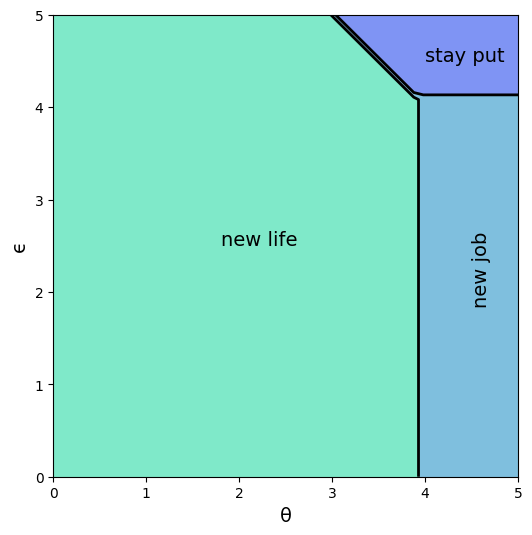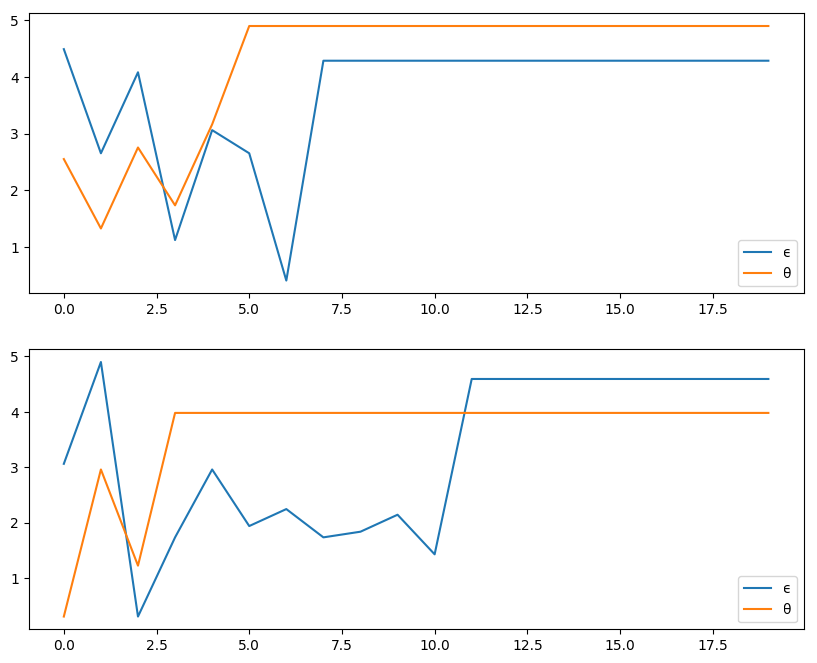34. Job Search IV: Modeling Career Choice#
34.1. Overview#
Next we study a computational problem concerning career and job choices.
The model is originally due to Derek Neal [Nea99].
This exposition draws on the presentation in [LS18], section 6.5.
34.1.1. Model features#
Career and job within career both chosen to maximize expected discounted wage flow.
Infinite horizon dynamic programming with two state variables.
using LinearAlgebra, Statistics, NLsolve
34.2. Model#
In what follows we distinguish between a career and a job, where
a career is understood to be a general field encompassing many possible jobs, and
a job is understood to be a position with a particular firm
For workers, wages can be decomposed into the contribution of job and career
\(w_t = \theta_t + \epsilon_t\), where
\(\theta_t\) is contribution of career at time \(t\)
\(\epsilon_t\) is contribution of job at time \(t\)
At the start of time \(t\), a worker has the following options
retain a current (career, job) pair \((\theta_t, \epsilon_t)\) — referred to hereafter as “stay put”
retain a current career \(\theta_t\) but redraw a job \(\epsilon_t\) — referred to hereafter as “new job”
redraw both a career \(\theta_t\) and a job \(\epsilon_t\) — referred to hereafter as “new life”
Draws of \(\theta\) and \(\epsilon\) are independent of each other and past values, with
\(\theta_t \sim F\)
\(\epsilon_t \sim G\)
Notice that the worker does not have the option to retain a job but redraw a career — starting a new career always requires starting a new job.
A young worker aims to maximize the expected sum of discounted wages.
subject to the choice restrictions specified above.
Let \(V(\theta, \epsilon)\) denote the value function, which is the maximum of (34.1) over all feasible (career, job) policies, given the initial state \((\theta, \epsilon)\).
The value function obeys
where
Evidently \(I\), \(II\) and \(III\) correspond to “stay put”, “new job” and “new life”, respectively.
34.2.1. Parameterization#
As in [LS18], section 6.5, we will focus on a discrete version of the model, parameterized as follows:
both \(\theta\) and \(\epsilon\) take values in the set
linspace(0, B, N)— an even grid of \(N\) points between \(0\) and \(B\) inclusive\(N = 50\)
\(B = 5\)
\(\beta = 0.95\)
The distributions \(F\) and \(G\) are discrete distributions
generating draws from the grid points linspace(0, B, N).
A very useful family of discrete distributions is the Beta-binomial family, with probability mass function
Interpretation:
draw \(q\) from a \(\beta\) distribution with shape parameters \((a, b)\)
run \(n\) independent binary trials, each with success probability \(q\)
\(p(k \,|\, n, a, b)\) is the probability of \(k\) successes in these \(n\) trials
Nice properties:
very flexible class of distributions, including uniform, symmetric unimodal, etc.
only three parameters
Here’s a figure showing the effect of different shape parameters when \(n=50\).
using LaTeXStrings, Plots, Distributions
n = 50
a_vals = [0.5, 1, 100]
b_vals = [0.5, 1, 100]
plt = plot()
for (a, b) in zip(a_vals, b_vals)
ab_label = L"$a = %$a, b = %$b$"
dist = BetaBinomial(n, a, b)
plot!(plt, 0:n, pdf.(dist, support(dist)), label = ab_label)
end
plt
Implementation:
The code for solving the DP problem described above is found below:
function CareerWorkerProblem(; beta = 0.95,
B = 5.0,
N = 50,
F_a = 1.0,
F_b = 1.0,
G_a = 1.0,
G_b = 1.0)
theta = range(0, B, length = N)
epsilon = copy(theta)
dist_F = BetaBinomial(N - 1, F_a, F_b)
dist_G = BetaBinomial(N - 1, G_a, G_b)
F_probs = pdf.(dist_F, support(dist_F))
G_probs = pdf.(dist_G, support(dist_G))
F_mean = sum(theta .* F_probs)
G_mean = sum(epsilon .* G_probs)
return (; beta, N, B, theta, epsilon, F_probs, G_probs, F_mean, G_mean)
end
function update_bellman!(cp, v, out; ret_policy = false)
# new life. This is a function of the distribution parameters and is
# always constant. No need to recompute it in the loop
v3 = (cp.G_mean + cp.F_mean .+ cp.beta .* cp.F_probs' * v * cp.G_probs)[1] # do not need 1 element array
for j in 1:(cp.N)
for i in 1:(cp.N)
# stay put
v1 = cp.theta[i] + cp.epsilon[j] + cp.beta * v[i, j]
# new job
v2 = (cp.theta[i] .+ cp.G_mean .+ cp.beta .* v[i, :]' * cp.G_probs)[1] # do not need a single element array
if ret_policy
if v1 > max(v2, v3)
action = 1
elseif v2 > max(v1, v3)
action = 2
else
action = 3
end
out[i, j] = action
else
out[i, j] = max(v1, v2, v3)
end
end
end
end
function update_bellman(cp, v; ret_policy = false)
out = similar(v)
update_bellman!(cp, v, out, ret_policy = ret_policy)
return out
end
function get_greedy!(cp, v, out)
update_bellman!(cp, v, out, ret_policy = true)
end
function get_greedy(cp, v)
update_bellman(cp, v, ret_policy = true)
end
get_greedy (generic function with 1 method)
The code defines
a named tuple
CareerWorkerProblemthatencapsulates all the details of a particular parameterization
implements the Bellman operator \(T\)
In this model, \(T\) is defined by \(Tv(\theta, \epsilon) = \max\{I, II, III\}\), where \(I\), \(II\) and \(III\) are as given in (34.2), replacing \(V\) with \(v\).
The default probability distributions in CareerWorkerProblem correspond to discrete uniform distributions (see the Beta-binomial figure).
In fact all our default settings correspond to the version studied in [LS18], section 6.5.
Hence we can reproduce figures 6.5.1 and 6.5.2 shown there, which exhibit the value function and optimal policy respectively.
Here’s the value function
wp = CareerWorkerProblem()
v_init = fill(100.0, wp.N, wp.N)
func(x) = update_bellman(wp, x)
sol = fixedpoint(func, v_init)
v = sol.zero
plot(linetype = :surface, wp.theta, wp.epsilon, transpose(v),
xlabel = L"\theta",
ylabel = L"\epsilon",
seriescolor = :plasma, gridalpha = 1)
The optimal policy can be represented as follows (see Exercise 3 for code).

Interpretation:
If both job and career are poor or mediocre, the worker will experiment with new job and new career.
If career is sufficiently good, the worker will hold it and experiment with new jobs until a sufficiently good one is found.
If both job and career are good, the worker will stay put.
Notice that the worker will always hold on to a sufficiently good career, but not necessarily hold on to even the best paying job.
The reason is that high lifetime wages require both variables to be large, and the worker cannot change careers without changing jobs.
Sometimes a good job must be sacrificed in order to change to a better career.
34.3. Exercises#
34.3.1. Exercise 1#
Using the default parameterization in the CareerWorkerProblem,
generate and plot typical sample paths for \(\theta\) and \(\epsilon\)
when the worker follows the optimal policy.
In particular, modulo randomness, reproduce the following figure (where the horizontal axis represents time)

Hint: To generate the draws from the distributions \(F\) and \(G\), you can use the Categorical distribution from the Distributions package.
34.3.2. Exercise 2#
Let’s now consider how long it takes for the worker to settle down to a permanent job, given a starting point of \((\theta, \epsilon) = (0, 0)\).
In other words, we want to study the distribution of the random variable
Evidently, the worker’s job becomes permanent if and only if \((\theta_t, \epsilon_t)\) enters the “stay put” region of \((\theta, \epsilon)\) space.
Letting \(S\) denote this region, \(T^*\) can be expressed as the first passage time to \(S\) under the optimal policy:
Collect 25,000 draws of this random variable and compute the median (which should be about 7).
Repeat the exercise with \(\beta=0.99\) and interpret the change.
34.3.3. Exercise 3#
As best you can, reproduce the figure showing the optimal policy.
Hint: The get_greedy() method returns a representation of the optimal
policy where values 1, 2 and 3 correspond to “stay put”, “new job” and “new life” respectively. Use this and the plots functions (e.g., contour, contour!) to produce the different shadings.
Now set G_a = G_b = 100 and generate a new figure with these parameters. Interpret.
34.4. Solutions#
34.4.1. Exercise 1#
wp = CareerWorkerProblem()
function solve_wp(wp)
v_init = fill(100.0, wp.N, wp.N)
func(x) = update_bellman(wp, x)
sol = fixedpoint(func, v_init)
v = sol.zero
optimal_policy = get_greedy(wp, v)
return v, optimal_policy
end
v, optimal_policy = solve_wp(wp)
F = Categorical(wp.F_probs)
G = Categorical(wp.G_probs)
function gen_path(T = 20)
i = j = 1
theta_ind = Int[]
epsilon_ind = Int[]
for t in 1:T
# do nothing if stay put
if optimal_policy[i, j] == 2 # new job
j = rand(G)
elseif optimal_policy[i, j] == 3 # new life
i, j = rand(F), rand(G)
end
push!(theta_ind, i)
push!(epsilon_ind, j)
end
return wp.theta[theta_ind], wp.epsilon[epsilon_ind]
end
plot_array = Any[]
for i in 1:2
theta_path, epsilon_path = gen_path()
plt = plot(epsilon_path, label = L"\epsilon")
plot!(plt, theta_path, label = L"\theta")
plot!(plt, legend = :bottomright)
push!(plot_array, plt)
end
plot(plot_array..., layout = (2, 1))
34.4.2. Exercise 2#
The median for the original parameterization can be computed as follows
function gen_first_passage_time(optimal_policy)
t = 0
i = j = 1
while true
if optimal_policy[i, j] == 1 # Stay put
return t
elseif optimal_policy[i, j] == 2 # New job
j = rand(G)[1]
else # New life
i, j = rand(F)[1], rand(G)[1]
end
t += 1
end
end
M = 25000
samples = zeros(M)
for i in 1:M
samples[i] = gen_first_passage_time(optimal_policy)
end
print(median(samples))
7.0
To compute the median with \(\beta=0.99\) instead of the default value \(\beta=0.95\), replace wp=CareerWorkerProblem() with wp=CareerWorkerProblem(beta=0.99).
The medians are subject to randomness, but should be about 7 and 14 respectively. Not surprisingly, more patient workers will wait longer to settle down to their final job.
wp2 = CareerWorkerProblem(beta = 0.99)
v2, optimal_policy2 = solve_wp(wp2)
samples2 = zeros(M)
for i in 1:M
samples2[i] = gen_first_passage_time(optimal_policy2)
end
print(median(samples2))
14.0
34.4.3. Exercise 3#
Here’s the code to reproduce the original figure
wp = CareerWorkerProblem();
v, optimal_policy = solve_wp(wp)
lvls = [0.5, 1.5, 2.5, 3.5]
x_grid = range(0, 5, length = 50)
y_grid = range(0, 5, length = 50)
contour(x_grid, y_grid, optimal_policy', fill = true, levels = lvls,
color = :Blues,
fillalpha = 1, cbar = false)
contour!(xlabel = L"\theta", ylabel = L"\epsilon")
annotate!([(1.8, 2.5, text("new life", 14, :white, :center))])
annotate!([(4.5, 2.5, text("new job", 14, :center))])
annotate!([(4.0, 4.5, text("stay put", 14, :center))])
Now, we need only swap out for the new parameters
wp = CareerWorkerProblem(G_a = 100.0, G_b = 100.0); # use new params
v, optimal_policy = solve_wp(wp)
lvls = [0.5, 1.5, 2.5, 3.5]
x_grid = range(0, 5, length = 50)
y_grid = range(0, 5, length = 50)
contour(x_grid, y_grid, optimal_policy', fill = true, levels = lvls,
color = :Blues,
fillalpha = 1, cbar = false)
contour!(xlabel = L"\theta", ylabel = L"\epsilon")
annotate!([(1.8, 2.5, text("new life", 14, :white, :center))])
annotate!([(4.5, 2.5, text("new job", 14, :center))])
annotate!([(4.0, 4.5, text("stay put", 14, :center))])
You will see that the region for which the worker will stay put has grown because the distribution for \(\epsilon\) has become more concentrated around the mean, making high-paying jobs less realistic.
